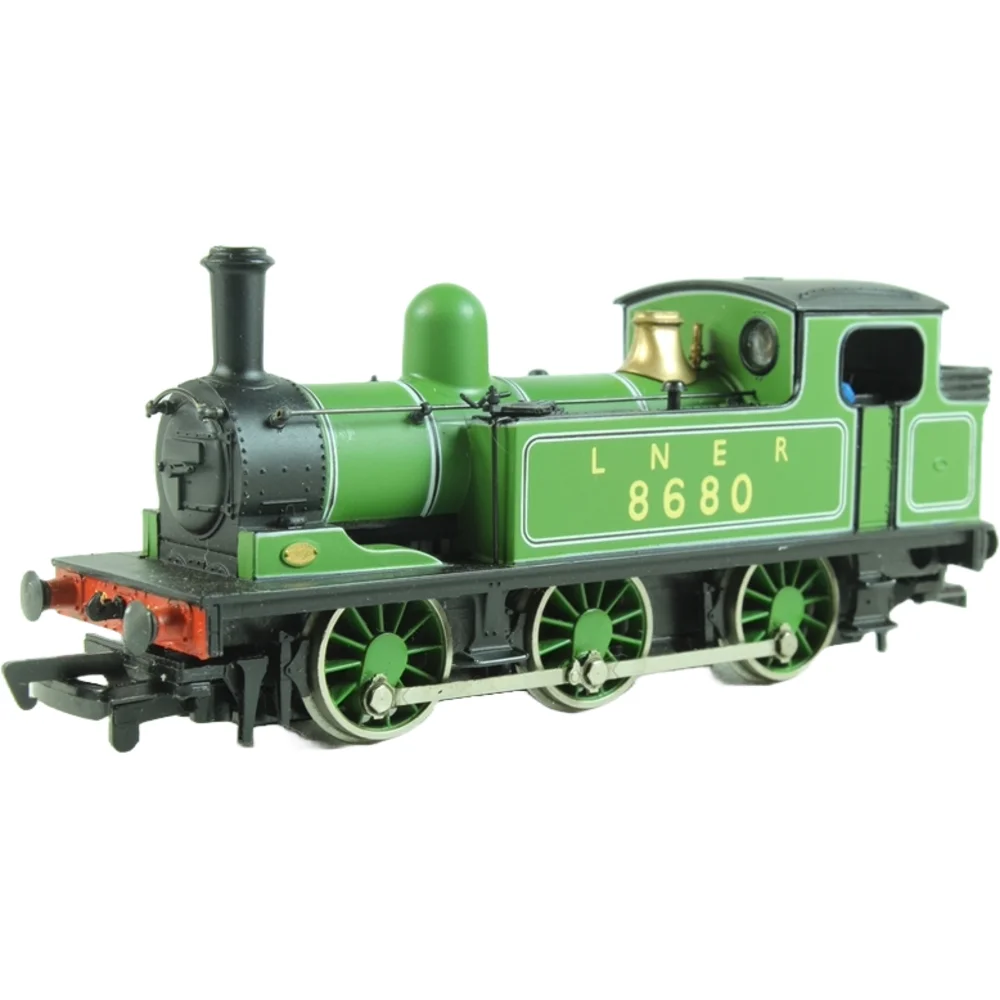Bachmann 31-050
London & North Eastern Railway J72 8680 London & North Eastern Railway Lined Apple Green
Tooling
The LNER Class J72 (originally NER Class E1) was a small 0-6-0T shunting locomotive designed by Wilson Worsdell and built between 1898 and 1951. Its longevity and simplicity made it a popular subject for ready-to-run models. The first OO gauge J72 appeared in 1976 under the Mainline Railways brand, and when Bachmann entered the UK market in the early 1990s, they adopted this tooling for their Branchline range. This tooling remained in production until 2008, when a completely new model was introduced.
Tooling Features
- Scale: OO gauge (1:76).
- Construction: Plastic body shell with die-cast split chassis frame.
- Detailing: Considered advanced for its time, featuring separately fitted wire handrails and fine livery application.
- Couplings: Standard tension-lock couplers mounted on the chassis.
Mechanical & Electrical
- Motor & Drive: Powered by a pancake motor mounted in the split chassis, driving all three axles.
- Minimum Radius: Suitable for standard OO curves (approx. 2nd radius).
- Lighting: None fitted.
- Weighting: Moderate weight from die-cast chassis, aiding traction for shunting duties.
DCC Capability
The original tooling was not DCC ready. Conversion required significant modification or replacement chassis kits. Later Bachmann retooling (post-2008) introduced 8-pin and later 18-pin DCC sockets, but these were absent from the 1990-era models.
Liveries Produced
Across its production life, the ex-Mainline tooling appeared in a wide range of authentic schemes, including:
- NER green
- LNER lined black
- LNER plain black
- BR black (early and late crests)
- BR lined black and green (specials)
These liveries reflected the prototype’s long service life under NER, LNER, and BR.
Performance & Reviews
While praised for its appearance and detailing, the model’s performance was often criticized. The split chassis design avoided wiper pickups but introduced reliability issues, and the pancake motor limited smooth running. Wheel quartering problems were common in early examples, though later friction-fit wheels improved matters slightly.
Media & Community Commentary
Enthusiasts frequently note the J72’s historical significance as one of the first highly detailed RTR tank engines in OO gauge. Social media and forums often describe the model as “charming but dated,” with many recommending chassis replacement kits for improved running. The tooling is fondly remembered for its role in raising detailing standards in the 1970s and 1980s.
Interesting Facts
- The prototype J72 class was built over an extraordinary 53-year span, making it unique among British steam designs.
- The Bachmann model retained the Mainline body tooling almost unchanged for nearly two decades before retooling in 2008.
Class & Prototype
- Class: London & North Eastern Railway J72
- Traction: Steam
- Built: 1898-1951
- Total Built: 113
- Running Number: 8680
- Ordered By: North Eastern Railway
- Built By: North Eastern Railway
- Built At: Darlington
- Built: 03/1899
- Withdrawn: 10/1961
- Length of Service: 62.6 years
- Running Numbers: NER 1720, LNER 8680, BR 68680
- Names: -
Operator & Livery
- Operator: London & North Eastern Railway
- Livery: Lined Apple Green
- Era: 3 - The big 4 – LMS, GWR, LNER & SR
The London & North Eastern Railway emerged in 1923 as Britain's second-largest railway company, combining seven major railways including the Great Northern, North Eastern, and Great Eastern into a 6,590-mile network stretching from London's four terminals to the Scottish Highlands. Despite serving economically challenged industrial regions, the LNER achieved worldwide recognition for engineering excellence and speed records that remain unbroken today.
Under Chief Mechanical Engineers Sir Nigel Gresley, Edward Thompson, and Arthur Peppercorn, the LNER developed revolutionary locomotive designs characterised by three-cylinder layouts and streamlined aesthetics. Gresley's masterpieces included the A1 Pacifics featuring Flying Scotsman and the legendary A4 class, culminating in Mallard's world steam speed record of 126 mph in 1938.
The company pioneered luxury express services including the Silver Jubilee and Coronation streamliners, whilst investing in forward-thinking electrification schemes and massive marshalling yards. Notable achievements included operating the complete East Coast Main Line, introducing Britain's first regular 400-mile non-stop service, and commissioning Eric Gill's iconic typography that influenced railway design for decades.
Nationalised in 1948, LNER locomotives continued serving British Railways until the 1960s, with some A4 Pacifics working Scottish expresses until 1966. Today, the LNER's engineering legacy thrives through extensive preservation, new-build projects like Tornado, and comprehensive model ranges covering every major class in all popular scales, making LNER subjects essential for discerning railway modellers seeking authentic British steam-age atmosphere.
